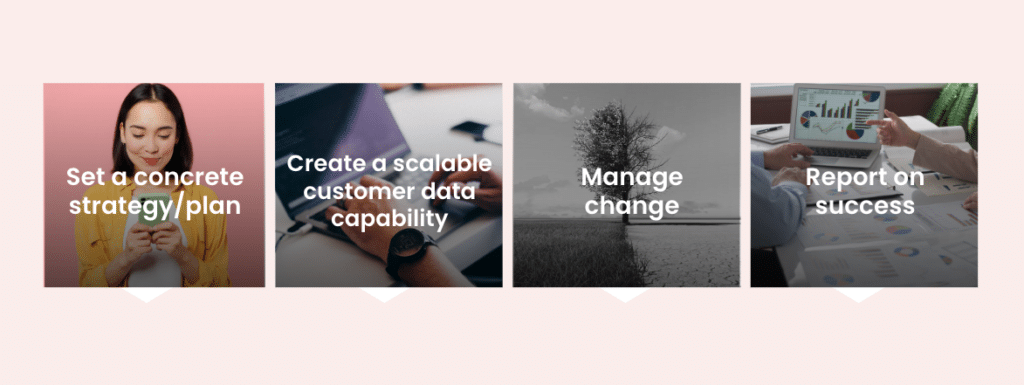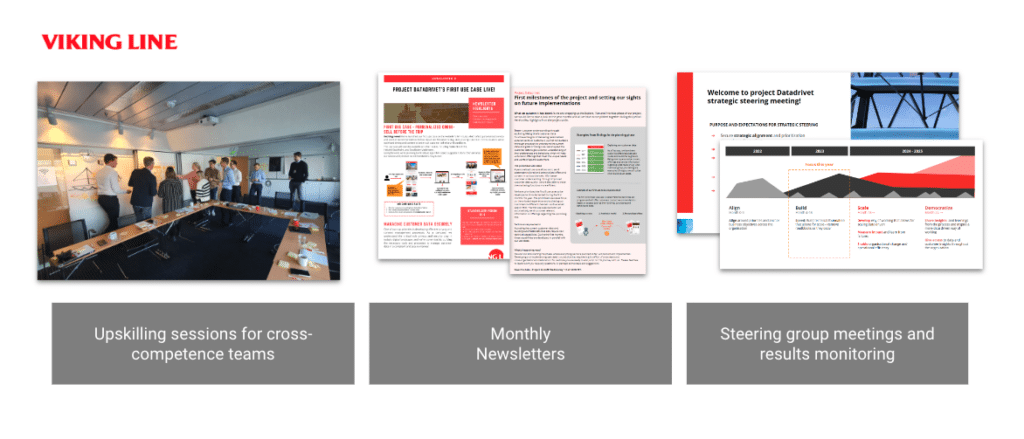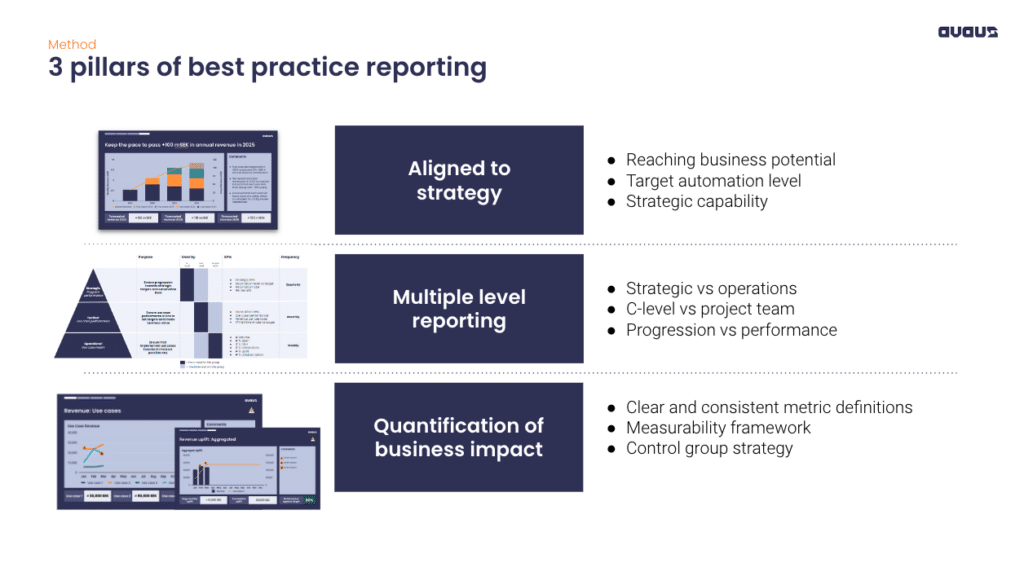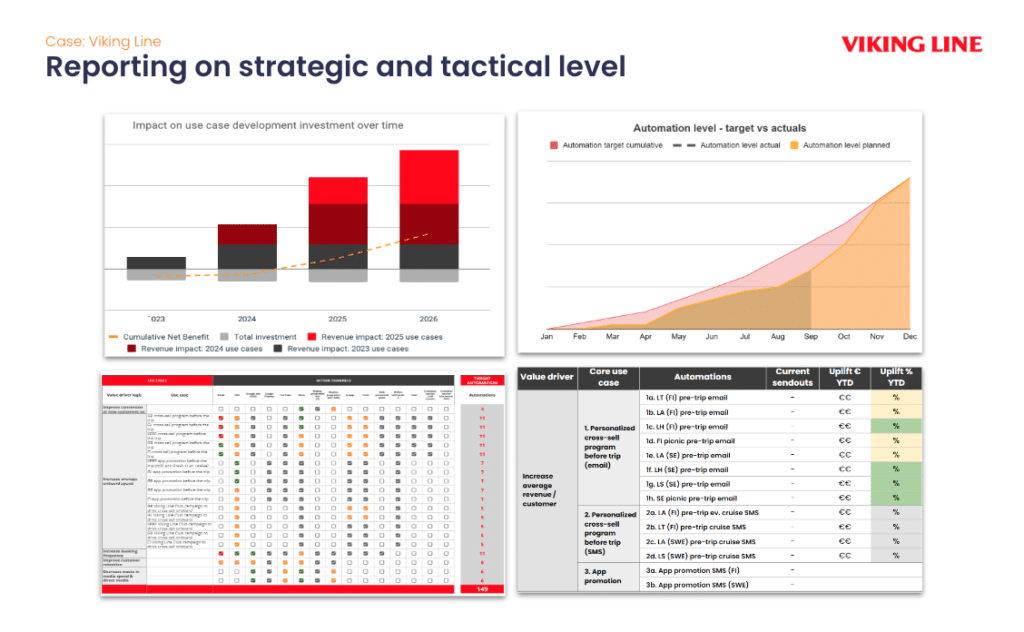Every business strives to harness the power of data to make informed decisions and gain a competitive edge. This was also the case for Viking Line, the market-leading brand in passenger traffic on the Northern Baltic Sea.
Instead of just dreaming about one day utilising all their customer data in smart ways — Viking Line decided to take action. They started out by having a workshop on the topic internally and quickly identified a need for an external partner.
Most companies looking to become data-driven will soon discover that it can be challenging without a clear roadmap. That’s exactly why we at Avaus, with over 15 years of experience in the field of customer data, have developed a solid methodology to ensure a smooth process and great results.
4 proven methods to accelerate your data-driven journey
We will walk you through how we at Avaus have worked together with Viking Line to help them become data-driven.
It’s based on, and a summary of, the webinar “Accelerate your data-driven journey: 4 proven methods” where our CEO Emma Storbacka was joined by CTO Eldar Terzic, Senior Strategy Consultant Jenny Sandqvist, Viking Line’s CDO Tom Lindberg and Digital & CRM Manager Nordic Niklas Andersson.
We hope to provide you with some insights on how to face the different challenges of becoming a data-driven organisation. In addition, you’ll get to learn about the four methods that will help your transformation.

You can also watch the webinar in full here.
Method 1: Create a concrete strategy towards the vision
This might seem obvious, but setting a concrete strategy for your data-driven journey is crucial. Why is that? Because most companies unfortunately struggle to turn their investments in marketing, technology, data, and competent personnel into value.
This can be due to the lack of a shared language between IT and the business, which makes it challenging to understand each other’s perspectives. Often, the vision remains vague, such as wanting to be “personalised” or “customer-centric,” without translating these aspirations into actionable use cases.
Pain points at this stage
These are some of the challenges that we see repeatedly throughout organisations:
- You lack a shared language between business & IT.
- You don’t have clear targets (e.g. what does it mean in concrete action.s and use cases?)
- You find it hard to prioritise and don’t know where to start.
Viking Line could recognise themselves in this and knew when initiating the collaboration with Avaus that it was all a question of building trust.
“We had to get top management on-board. We understood that, at the same time as you build a business case, you also need to be pragmatic and start to talk about use cases. Talk about what you actually will do and how you will measure it. This was a good combination. They started to understand what we needed to do and we built this trust.” – Tom Lindberg, CDO, Viking Line.
Could we say that trust comes from granularity? Well, probably. It’s important to be concrete enough as well as having a clear story about how you will work, what happens first and what will happen later. And last but not least: you need to talk about how it will be measured.
Recommendations for building your strategy
- Align with key stakeholders in the organisation. In the case of Viking Line, this meant getting into a workshop with 15 people and getting everyone onboard.
- Develop a clear business case with long-term vision (3-5 years). What’s the goal and how will we get there?
- Take a granular planning and step-by-step approach. Normally these steps include a prestudy, followed by a planning phase before the actual development work starts.
Method 2: Build a scalable customer data capability
Now we come to the second part of how to ensure the success of the project and this is where you should bring your CTO into the conversation. As this part tends to get quite technical, it’s important to have someone with technical expertise involved – and this person will probably be more excited about this stuff than you might feel.
So the second step of accelerating your data-driven journey is all about building a scalable customer data capability. The focus here is on the word scalable. Why is this so important? Let’s our CTO at Avaus explain it:
“Typically you will invest in a customer data platform (CDP). However, if your customer data is not structured in a smart way in your cloud environment, you will be redesigning that data to fit into the CDP. This truly doesn’t fit any other needs you have in the organisation. That’s a lot of effort for something that shouldn’t be a problem. You’re trying to design your data so it fits the vendor instead of implementing the vendor so it supports your organisation, by taking the data in the best manner.” – Eldar Terzic, CTO, Avaus
Pain points at this stage
The four typical challenges you are likely to face when building your customer data capability based on a SaaS solution (like a CDP) are:
- The Saas tools data models are predefined and based on the tool requirements, not on your needs.
- Customer Data Platforms (CDPs) are often locked into a specific vendor’s ecosystem, making it difficult to customise or adapt.
- As your data-driven actions get more advanced, your needs will likely change but the software may not have much flexibility.
- The SaaS fixed structure can mean paying for unnecessary features while missing out on the ones you need.
The customised solution we built for Viking Line, in order to recognise the need for a flexible and data-centric approach, was through microservices architecture and utilising use cases. This means that Viking Line now has a much more scalable and structured customer data capability, compared to if they would have implemented a traditional CDP.
Recommendations for building a scalable customer data capability
- Build the end-to-end capability use case by use case, instead of trying to solve all challenges at once. By implementing them one by one, you’ll also see results faster and understand if you are on the right track.
- Enable microservice based architecture for flexibility and to open up the use of data to many.
- Fix the data at the core. Adding a new, shiny SaaS solution in your infrastructure will probably not solve the problems.
Method 3: Manage the organisational change — for skill and will
The third method centres around the holy topic of Change Management. Becoming data-driven doesn’t happen only within the IT or marketing department, it’s essentially a shift in mindset and behaviour for the whole organisation. This transformation might start in one corner, but the idea is to let it spread inside the organisation in order to truly become data-driven.
What we’ve discovered is that most companies are not focusing enough on how to manage this change. Thus, we take pride in highlighting it as one of the four methods. It has also been highly appreciated by our customers, that we support them throughout the project and align the different departments and stakeholders.
As Emma points out, “Change management is a topic that’s always been very important at Viking Line. I’ve been very impressed with your way of looking at the change management topic as being equally important as the technical solution and the results.”
Pain points at this stage
Managing the change to a data-driven approach often poses some challenges:
- Lack of clarity. What does “becoming data-driven” really mean? You’ll need to clearly define and agree on this.
- Internal resistance. As people don’t want or don’t know how to change, they might need help in navigating what will be needed or expected from them in this “new world”.
- Communication challenges. As the change is complex and might mean different things for different people, you should communicate it repeatedly for better understanding.
There are different ways to address these challenges. Viking Line opted for upskilling sessions for their cross-competence teams. They also released an internal newsletter once a month with the project updates and defined some steering group meetings and results monitoring methods.

In order to manage change successfully we’d like to say that you’ll need to manage both the skill and will of your team. Keeping people motivated and giving them the opportunity to upskill will be crucial in this process.
Recommendations for managing change
- Plan for change management from the start. Who do we need to involve? Make sure to involve all stakeholders in the change management process.
- Implement the actions systematically and on different levels throughout the project.
- Prepare to measure change success – and iterate as you learn!
Method 4: Measure the success (from the start)
The final method is measuring success from the beginning of your data-driven journey.
As Jenny Sandqvist explained Avaus’ approach with Viking Line:
“A very important part is that we measure what we do. We want to show all the technical parts and work together, co-code, and plan for the use cases. But also, we really want to anchor our collaboration in the results.”
Pain points at this stage
Reporting is vital in order to know if you are getting any return on your investment, but it can be a problematic phase if:
- Unclear and irrelevant KPIs make it hard to measure success.
- A poor reporting system hinders data collection and analysis.
- No one is in charge of tracking success.
- Results are not shared with the people involved, leading to resistance to change.
Often organisations neglect reporting and tracking progresses. This leads to confusion and lack of alignment with the strategy. Clear KPIs, technical solutions, and automated reporting are essential for success.

Following Viking Line’s example, you should build both strategic and tactical reports.

Recommendations for measuring the results
- Create a good reporting framework. This will be required for further investment, but is still often neglected. You also need to follow up on the numbers and KPIs systematically.
- Automate the reporting framework. The technical capabilities are needed as well as something to compare with, i.e. control groups.
- Ensure you have a strategy for going forward with the use cases. Focus on volume and impact first, and then go into the details of the relevance and personalisation.
Feeling inspired by Viking Line?
Are you ready to embark on your data-driven journey just like Viking Line? Whether you’re just starting or looking to enhance your existing strategy, Avaus can help you.
Get in touch and explore how we can tailor our solutions to your needs.